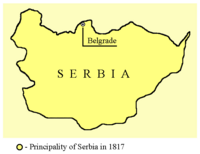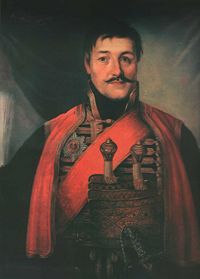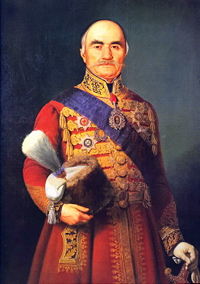Serbian revolution
Serbian revolution or Revolutionary Serbia refers to the national and social revolution of the Serbian people between 1804 and 1817, during which Serbia managed to emancipate from the Ottoman Empire and exist as a sovereign European nation-state. The revolution was inspired by the developing concept of the nation state itself stimulated by the French Revolution. Serbs were encouraged by Russia to re-assert their national and ethnic identity and found inspiration too in memories of their brief imperial past. The term "Serbian revolution" was invented by a famous German historian Leopold von Ranke in his book Die Serbische Revolution, published in 1829.[1] These events marked the foundation of modern Serbia.[2] By 1817, Serbia was constituted as a Principality under the rule of Miloš Obrenović. It was not until 1878 that the Ottomans officially recognized Serbia's independence. In 1882 the Principality became a kingdom and in 1918 united with Croata, Slovenia and Bosnia to form what later became Yugoslavia. Dominated by the Serbian royal family, for many Serbs, this resurrected the Serbian Empire, or Greater Serbia.
Timeframe
The revolution underwent several phases:
- First Serbian Uprising (1804- 1813), led by Karađorđe Petrović
- Hadži Prodan's revolt (1814)
- Second Serbian Uprising (1815) under Miloš Obrenović
The Proclamation[3] (1809) by Karadjordje Petrović in the capital Belgrade represented the peak of the revolution. It called for unity of the Serbian nation, emphasising the importance of freedom of religion, Serbian history and rule of law- all of which Ottoman Empire couldn't- or has denied to provide, beeing a non-secular Muslim state. </ref> It also called on Serbs to stop paying taxes to the Porte because they were based on religious affiliation.
Background (1791-1804)
Kočina Krajina Serb rebellion was an uprising of Serbs against the Ottoman Empire from Feb 1788 - 7 Sep 1788. Koča Andjelković (b. 1755 - d. 1788)[4] was the leader of the uprising which was aided by the Habsburg Empire. It enabled the Habsburgs to conquer Serbia from the Ottomans, attaching the territory of the Pashaluk of Belgrade to other Serb-populated areas of their Empire. The crownland of (third) Habsburg Serbia existed for 3 years.[5]
By 1791 however the Austrians were forced into withdrawal across the Danube and Sava rivers, joined by thousands of Serbian families who feared Ottoman revenge for supporting the Habsburgs. Retaliation of the Ottomans in the outset of the uprising influenced the Serb determination to emancipate from the Ottomans 15 years later, during the Serbian revolution.
The withdrawal of the Austrians from Serbia in 1791 marked the end of the Kočina Krajina Serb rebellion, which was ignited by Austria. Ottoman Empire annexed the Pashaluk of Belgrade, retaliated against the perpertrators of the uprising and their families, thus forcing thousands into exile in Austria. Reforms made by the Porte to ease the pressure on Serbs were only temporary; by 1799 the Janissary corps have returned, suspended the Serb autonomy and drastically increased taxes, enforcing martial law in Serbia.
Serb leaders from both sides of the Danube began to conspire against the dahias. When they found out, they rounded up and murdered tens of Serbian noblemen on the main square of Valjevo in an event known today as Seča knezova (Massacre of Serbian knights on February 4, 1804). The massacre outraged the Serbian people and incited the revolt across the Pashaluk of Belgrade. Within days, in the small Šumadija village of Orašac, the Serbs gathered to proclaim the uprising, electing Karađorđe Petrović as the leader. That afternoon, a Turkish inn (caravanserai) in Orašac was burned and its residents fled or were killed, followed by similar actions country-wide. Soon the cities Valjevo and Požarevac were liberated, and the siege of Belgrade launched.
Revolution erupts: First Serbian Uprising
During almost 10 years of the First Serbian Uprising (1804-1813), Serbia perceived itself as an independent state for the first time after 300 years of Ottoman and short-lasting Austrian occupations. Revolutionary Serbia responded to the Ottoman Massacre of Serbian knights by establishing its separate institutions, such as the government (Praviteljstvujusci Sovjet), Serbian Prince, Parliament (Zbor) and University of Belgrade. Following the French invasion in 1812 the Russian Empire witdrew its support for the Serb rebels; unwilling to accept Ottoman conditions, Serbs were fought into submission following the brutal Ottoman incursion into Serbia.[6]
Hadži Prodanova buna
Despite the lost battle, the tensions nevertheless persisted. In 1814 an unsuccessful Hadži Prodan's revolt was launched by Hadži Prodan Gligorijević, one of the veterans of the First Serbian Uprising. He knew the Turks would arrest him, so he thought it would be the best to resist the Ottomans; Milos Obrenović, another veteran, felt the time was not right for an uprising and did not provide assistance.
Hadži Prodan's Uprising soon failed and he fled to Austria. After the failure of this revolt, the Turks inflicted more persecution against the Serbs, such as high taxation, forced labor, and rape. In March 1815, Serbs had several meetings and decided upon a new revolt.
Second Serbian Uprising
The Second Serbian Uprising (1815-1817) was the second phase of the national revolution. The revolutionarry council proclaimed an uprising in Takovo on April 23 1815, with Milos Obrenović chosen as the leader. When the Ottomans discovered this they sentenced all of its leaders to death. The Serbs fought in battles at Ljubic, Čačak, Palez, Požarevac and Dublje and managed to reconquer the Pashaluk of Belgrade.
Negotiations with the Porte (Ottoman Emperor)
In mid 1815, the first negotiations began between Obrenović and Marashli Ali Pasha, the Ottoman governor. The result was acknowledgment of a Serbian Principality by the Ottoman Empire. Although technically a suzerain of the Porte (to whom a yearly tax tribute was paid), it was, in most respects, an independent state.
By 1817, Obrenović succeeded in forcing Marashli Ali Pasha to negotiate an unwritten agreement, thus ending the Second Serbian uprising. The same year, Karadjordje, the leader of the First Uprising (and Obrenović's rival for the throne) returned to Serbia and was assassinated by Obrenović's orders; Obrenović consequently received the title of Prince of Serbia.
The Convention of Ackerman (1828), the Treaty of Adrianople (1829) and finally, the Hatt-i Sharif (1830), formally recognised the suzerainty of Principality of Serbia with Miloš Obrenović I as its hereditary Prince.
ReferencesISBN links support NWE through referral fees
- ↑ Ranke, Leopold. 1847. A History of Servia and the Servian Revolution. Translated from the German by Mrs Alexander Kerr. London: John Murray
- ↑ Stavrianos, pages 248-250.
- ↑ 2002. Povest - Prikljucenije (Proclamation) Retrieved July 11, 2008.
- ↑ Western Balkans
- ↑ Dorich, William. The Heavenly Kingdom in Serbia's Historic Destiny Retrieved July 11, 2008.
- ↑ The History of Yugoslavia Serbia and Montenegro until 2006 Third World Traveler. Retrieved July 11, 2008.
References
- Cox, John K. 2002. The history of Serbia. The Greenwood histories of the modern nations. Westport, CT: Greenwood Press. ISBN 9780313312908
- Forbes, Nevill, Arnold Joseph Toynbee, David Mitrany, and D. G. Hogarth. 1915. The Balkans; a history of Bulgaria, Serbia, Greece, Rumania, Turkey. Oxford: Clarendon Press New York. ISBN 9780404024574
- Jelavich, Barbara. 1991. Russia's Balkan entanglements, 1806-1914. Cambridge [England]: Cambridge University Press. ISBN 9780521401265
- Kardosch, Velizar M. 1996. The principality of Serbia: postal history and postage stamps, 1830-1882. Romanshorn, Switzerland: V.M. Kardosch. ISBN 9783952108314
- Pavlowitch, Stevan K. 2002. Serbia: the history of an idea. New York: New York University Press. ISBN 9780814767085
- Petrovich, Michael Boro. 1976. A history of modern Serbia, 1804-1918. New York: Harcourt Brace Jovanovich. ISBN 9780151409501
- Stavrianos, L. S. 2000. The Balkans since 1453. London: Hurst and Co. ISBN 9780030096853</ref>
Credits
New World Encyclopedia writers and editors rewrote and completed the Wikipedia article in accordance with New World Encyclopedia standards. This article abides by terms of the Creative Commons CC-by-sa 3.0 License (CC-by-sa), which may be used and disseminated with proper attribution. Credit is due under the terms of this license that can reference both the New World Encyclopedia contributors and the selfless volunteer contributors of the Wikimedia Foundation. To cite this article click here for a list of acceptable citing formats.The history of earlier contributions by wikipedians is accessible to researchers here:
- Serbian_Revolution history
- Krajina Serb rebellion&oldid=216401986 Kočina Krajina Serb rebellion Krajina Serb rebellion&action=history history
The history of this article since it was imported to New World Encyclopedia:
Note: Some restrictions may apply to use of individual images which are separately licensed.


